|
F4U-1A/D Corsair
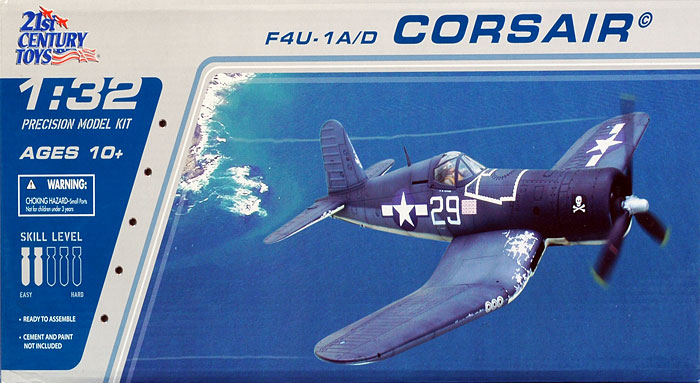
21st Century
Toys, 1/32
scale
S u m m a r y
|
|
Catalogue Number: |
21st
Century Toys kit number 22104 - Chance-Vought
F4U-1A/D Corsair |
|
Scale: |
1/32 |
|
Contents and Media: |
117 parts
in grey styrene; 6 parts in clear styrene;
markings for three aircraft. |
|
Price: |
around
USD$10.00 |
| Review
Type: |
FirstLook |
|
Advantages: |
Accurate outline;
relatively small parts
count and simple construction for new modellers; nice details and options; superb
pilot; excellent decal sheet; much improved
clear parts; outstanding
value |
|
Disadvantages: |
Some small
details missing in cockpit; some ambiguity
regarding identity;
construction method will leave large circles to
be filled and sanded |
|
Recommendation: |
Recommended for anyone wanting an easy 1/32
scale Corsair build, plus new modellers and those on a budget. |
Reviewed by Brett Green

HyperScale is proudly
supported by Squadron.com
21st Century Toys has been making a name for itself in
the collector's market with their large-scale, pre-assembled
and painted aircraft and military models. Now, 21st Century
Toys has expanded into plastic construction kits.
One of their latest 1/32 scale kit releases is an
F4U-1A/D Corsair.
This is not the first time that we have seen a Corsair in
large scale. Revell's 1970s-vintage F4U-1D was superseded in
2003 by Trumpeter's F4U-1D and F4U-4 kits. These were
generally accurate and well detailed offerings, but they
were burdened with overly complex engineering and workable
control surfaces, including moveable flaps and folding
wings, resulting in challenging construction (to put it
mildly). These kits also suffered from numerous minor
inaccuracies and omissions - disappointing for a $100+ kit.
21st Century Toys has chosen a very different path.
Control surfaces are moulded in place, wings are not
designed to be folded, and the approach seems to focus on
delivering a reasonably detailed kit with the minimum number
of parts.
21st Century Toys' 1/32
scale F4U-1A/D comprises 117 parts in grey plastic and
6
parts in clear, plus a bag of metal screws. The grey plastic
appears to be regular hard polystyrene, and responds
normally to model cements. Parts are not attached to sprues.
Instead, they are packed in small groups of loose parts in
separate plastic bags.
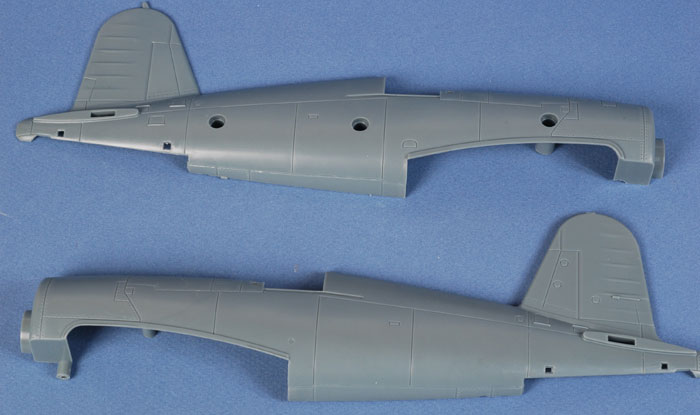
Click the
thumbnails below to view larger images:
[photogallery/photo00000432/real.htm]
Surface detail is by way of recessed panel lines and a
small number of rivet lines. The panel lines are very
slightly heavier than Trumpeter's Corsairs, but not as
exaggerated as some mainstream releases of late. In
addition, the surface of this kit is not peppered with rows
of recessed rivets. Fabric detail varies across the model,
but it ranges from very good (as on the rudder) to okay (on
the more uniformly raised fabric wing panels).
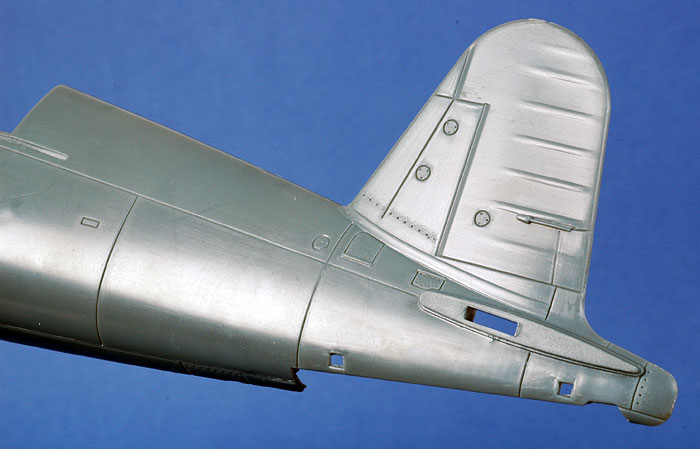
The outline of the kit conforms to scale drawings.
The canopy parts are clear and noticeably thinner than
those supplied in either the 21st Century Stuka or the Bf
109 kits. There is some distortion at the bottom port side
of the sliding section, but this may be a moulding
peculiarity on my sample. Clear parts include inserts for
wing top lights and the clear window in the bottom of the
fuselage, although this should be painted over for the -1A
and -1D variants.
Also, the "clear vision" style of canopy supplied is
typical of the F4U-1D. The -1A canopy featured an additional
diagonal frame near the top of each side of the sliding
section. This will be relatively easy to add either by
painting alone or by plastic strip.
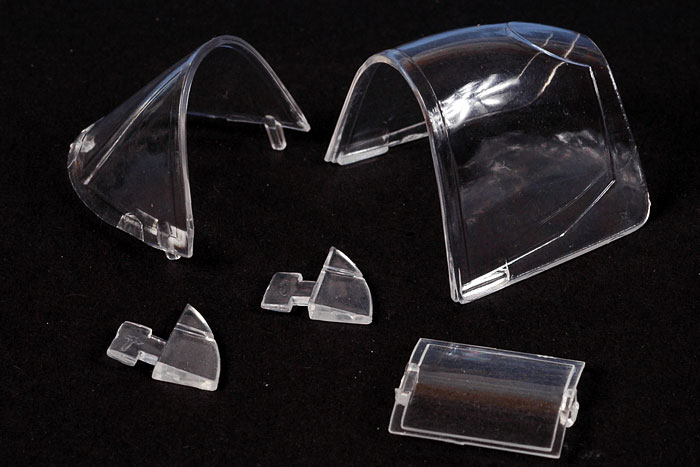
Most details are very nicely done, including the cockpit
side consoles, bulkheads and engine. The cockpit in general
is quite good, accurately depicting the floorless aspect of
the real thing (much more effectively than the Trumpeter
kit), but there are a couple of details missing.
I added a map case to the starboard side console from
plastic and lead foil, plus a handle to the quadrant on the
port side console.
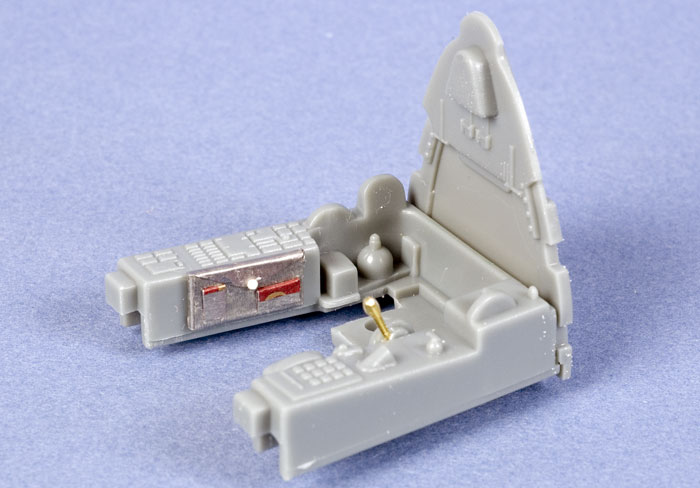
The prominent throttle quadrant is missing from the port
sidewall too. I cut and sanded a block of white styrene to
the approximate shape, and added throttle and mixture levers
from brass wire topped with knobs from super glue (you might
not be able to see the knobs now, but you will after they
have been painted).
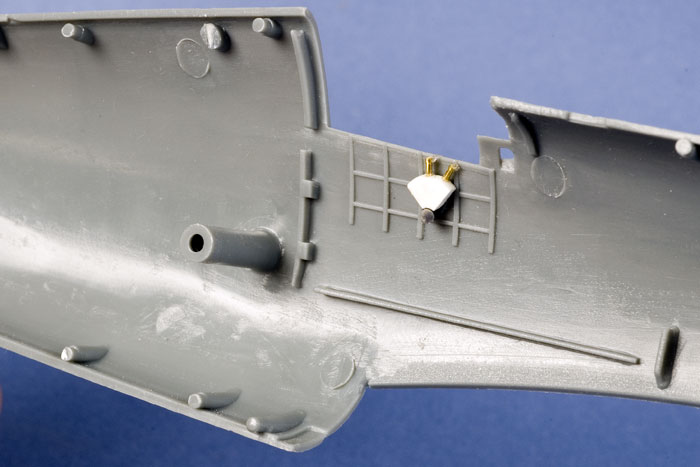
The seated pilot is up to the
same superb standard as those supplied in the 21st Century
Bf 109 and Stuka kits . This one is made up of a
body, two poseable arms, two legs and a separate head.
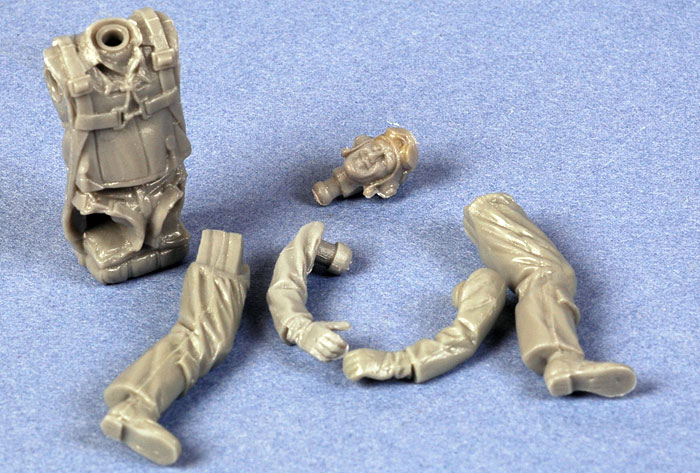
Options include inner wing pylons, drop tanks, rockets
and bombs. In fact, the relatively high parts count is
largely due to the inclusion of these 28 optional parts.
With these options and the style of canopy supplied, it
would appear that this kit best represents an F4U-1D
variant. However, the propeller seems closer to the 13' 4"
Hamilton Standard fitted to the -1A, but the base of each
blade is too quickly tapered and narrow to my eye. If you
leave off the ordnance (or fit only a single centreline
tank) and add the frames to the canopy, you will have
something close to a -1A.
Markings are supplied for three aircraft:
-
Lt.Jg. "Ike" Kepford's
famous F4U-1A attached to VF-17, the Jolly Rogers, on
Bougainville, mid 1944, finished in three colour
camouflage
-
an overall Glossy Sea
Blue aircraft, 167, of VF-84 on Bunker Hill, February
1945
-
an F4U-1D of VMF-441,
1945.
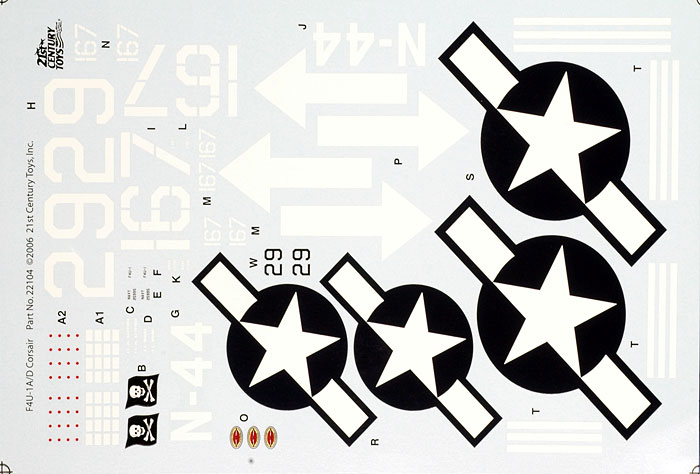
The decals are a real highlight - thinly printed, crisp
and plenty of detail.
Kit Engineering
I assume that, in addition to its current guise as a
construction kit, this mould will also be used as the basis
for a pre-built and painted static display model. That being
the case, kit engineering has been optimised for ease of
mass production by unskilled labour. The good news is that
it should be easy for new modellers to build too.
The first thing you will notice when you open the box are
a number of large holes in one fuselage side and on the
bottom of the wings. These are holes for the screws that hold
the main fuselage and wing assemblies together. Plastic
plugs are supplied to fill these holes, but these vary in
the standard of fit and, in any case, many modellers
will also want to fill and sand the circles.
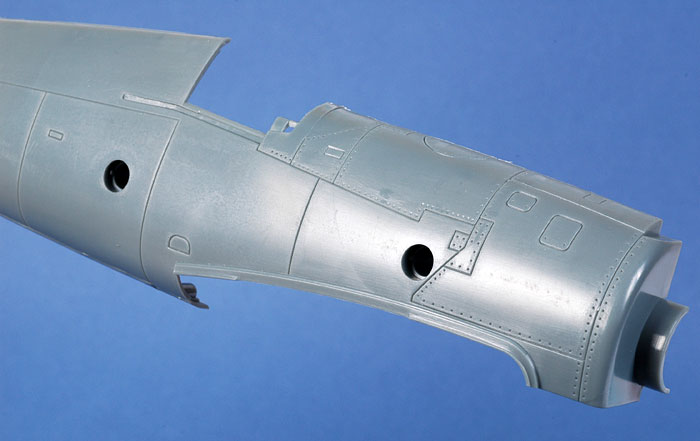
While building the Bf 109 kit I found the screws to be
hard going in the styrene, and a combination of the positive
locating pins and plastic glue seemed to do a fine job at
holding the parts together. I won't bother using the screws
this time around.
I do not see any reason that the Corsair should not be as
fast and easy to build as the 21st Century Bf 109 F.
21st Century Toys' 1/32 scale Corsair is accurate
in outline, nicely detailed, will be quite a fast
build and can be had for a pocket-money price.
This kit presents a stark contrast to the
Trumpeter Corsair F4U-1D in the same scale. I built one of
these kits back in 2004, and I still shudder at the memory
of fitting those workable control surfaces. The cockpit also
required serious rebuilding due to the inaccurate solid
floor. There is no question that detail was superior (the
engine was a work of art), but this was offset by the pain
of construction.
On the other hand, 21st Century Toys' new
offering is quite acceptably detailed, yet still presents
the modeller with the opportunity to add a few bits and
pieces to lift the standard. More importantly, it is not at
all intimidating, being perfectly suitable for beginner modellers
straight from the box.
We modellers do live in fortunate times. We
now have the option of 1/32 scale Corsairs, complex and
simple. Both have their place. I know that I will be happy
to put 21st Century's F4U-1A/D kit together. It might prove
to be effective therapy to recover from my earlier Corsair
experience, and it will look nice sitting next to my 1/32
scale Trumpeter Birdcage conversion!
Highly Recommended.
Thanks to 21st Century Toys for the sample.
Review and Text Copyright © 2007 by Brett
Green
Page Created 26 March, 2007
Last updated 31 December, 2007
Back to HyperScale Main Page
|
Home
| What's New |
Features |
Gallery |
Reviews |
Reference |
Forum |